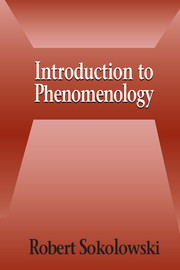Book contents
- Frontmatter
- Contents
- Acknowledgments
- Introduction
- 1 What Is Intentionality, and Why Is It Important?
- 2 Perception of a Cube as a Paradigm of Conscious Experience
- 3 Three Formal Structures in Phenomenology
- 4 An Initial Statement of What Phenomenology Is
- 5 Perception, Memory, and Imagination
- 6 Words, Pictures, and Symbols
- 7 Categorial Intentions and Objects
- 8 Phenomenology of the Self
- 9 Temporality
- 10 The Life World and Intersubjectivity
- 11 Reason, Truth, and Evidence
- 12 Eidetic Intuition
- 13 Phenomenology Defined
- 14 Phenomenology in the Present Historical Context
- Appendix: Phenomenology in the Last One Hundred Years
- Select Bibliography
- Index
4 - An Initial Statement of What Phenomenology Is
Published online by Cambridge University Press: 05 June 2012
- Frontmatter
- Contents
- Acknowledgments
- Introduction
- 1 What Is Intentionality, and Why Is It Important?
- 2 Perception of a Cube as a Paradigm of Conscious Experience
- 3 Three Formal Structures in Phenomenology
- 4 An Initial Statement of What Phenomenology Is
- 5 Perception, Memory, and Imagination
- 6 Words, Pictures, and Symbols
- 7 Categorial Intentions and Objects
- 8 Phenomenology of the Self
- 9 Temporality
- 10 The Life World and Intersubjectivity
- 11 Reason, Truth, and Evidence
- 12 Eidetic Intuition
- 13 Phenomenology Defined
- 14 Phenomenology in the Present Historical Context
- Appendix: Phenomenology in the Last One Hundred Years
- Select Bibliography
- Index
Summary
In order to understand what phenomenology is, we must make a distinction between two attitudes or perspectives that we can adopt. We must distinguish between the natural attitude and the phenomenological attitude. The natural attitude is the focus we have when we are involved in our original, world-directed stance, when we intend things, situations, facts, and any other kinds of objects. The natural attitude is, we might say, the default perspective, the one we start off from, the one we are in originally. We do not move into it from anything more basic. The phenomenological attitude, on the other hand, is the focus we have when we reflect upon the natural attitude and all the intentionalities that occur within it. It is within the phenomenological attitude that we carry out philosophical analyses. The phenomenological attitude is also sometimes called the transcendental attitude. Let us examine both attitudes or focuses, the natural and the phenomenological. We can understand each precisely in its contrast with the other.
THE NATURAL ATTITUDE
In our ordinary living, we are directly caught up with the various things in the world. As we sit conversing with others at the dinner table, as we walk to work, or as we fill out an application for a passport or for a driver's license, we have material objects presented to us, we identify them through the sides, aspects, and profiles through which they are given, we speak about and articulate them, we have emotional responses to things that are attractive or repellent, we find some things pleasant to look at or hear and others unpleasant and disruptive, and so on.
- Type
- Chapter
- Information
- Introduction to Phenomenology , pp. 42 - 65Publisher: Cambridge University PressPrint publication year: 1999



